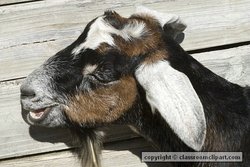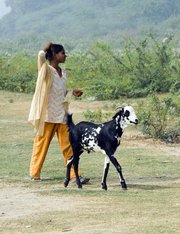Goat
|
|
| Capra | ||||||||||||||
|---|---|---|---|---|---|---|---|---|---|---|---|---|---|---|
| | ||||||||||||||
| Scientific classification | ||||||||||||||
|
A goat is an animal in the genus Capra, which consists of nine species: the Ibex, the West Caucasian Tur, the East Caucasian Tur, the Markhor, and the Wild Goat. The animal most commonly known as a "goat" is the domestic goat (Capra aegagrus hircus), a domesticated subspecies of the Wild Goat. Goats are bovines (members of the family Bovidae) and are related to cows and antelopes. They are widely scattered throughout Eurasia and Africa.
A male goat is called a buck or billy, and a female is called a doe. Young goats are called kids.
The Rocky Mountain Goat, despite its name, is not considered a true goat by scientists as it belongs to the genus Oreamnos.
| Contents |
Domestication and Uses
- Main article: Domestic goat
Along with sheep, goats were among the first domesticated animals, the domestication process starting at least 10,000 years ago. Easy human access to goat hair, meat, and milk were the primary motivations. Goat skins were popularly used until the Middle Ages for water and wine bottles when traveling and camping and as parchment for writing in certain regions.
The meat and milk of goats is still consumed, though not as commonly in the United States as in other regions of the world. Goat skin is still used to make kid gloves and other items of clothing. Certain breeds of goat produce a wool that can be made into sweaters and other wool items.
==Similarity to Sheep==The goat is closely related to the sheep, but differs from it in that the tail is shorter and the hollow horns are long and directed upward, backward, and outward while those of the sheep are spirally twisted. Unlike sheep, goats are equally suitable for herd and individual rearing. They are also much more lively than sheep and their inquisitive nature makes them curious pets.
Behavior
Goats are extremely curious and intelligent. They are known for escaping their pens and getting into mischief. Goats are also widely known for their ability to climb trees, although the tree generally has to be on somewhat of an angle. They may also jump on parked automobiles.
It is a stereotype that goats eat everything; this probably arises from the fact that they tend to chew (but not eat) almost anything. Goats prefer to browse shrubbery and weeds for food.
Goats in Folklore and Mythology
Since its inception, Christianity has associated goats with Satan. A common superstition in the Middle Ages was that goats whispered lewd sentences in the ears of the saints. The origin of this belief was probably the size of the male goat's phallus, which is unusually large. At those times, the depiction of a devil in the dark ages was generally that of a goat like face with horns and small beard (a goatee). The Black Mass, a probably-mythological "Satanic mass," was said to involve a black goat, a form in which Satan supposedly manifested himself for worship.
The goat has had a lingering connection with Satanism and pagan religions, even into modern times. The pentagram, a symbol used by both Satanism and Wicca, is said to be shaped like a goat's head. It is sometimes called the goat of Mendes, after a goat that supposedly copulated with priestesses during certain rituals in an ancient cult in Mendes, Greece.
The goat is also one of the twelve-year cycle of animals which appear in the Chinese zodiac related to the Chinese calendar. It is thought that each animal is associated with certain personality traits; those born in a year of the goat are predicted to be shy, introverted, creative, and perfectionistic. See Sheep (Zodiac).
The Capricorn sign in the Western zodiac is usually depicted as a goat with a fish's tail.
Species and subspecies
- Wild Goat (also "Bezoar Goat" or "Pasang"; Capra aegagrus)
- Domestic goat (Capra aegagrus hircus)
- Kri-kri (also "Cretan goat," "Agrimi," or "Cretan Ibex"; Capra aegagrus creticus)
- West Caucasian Tur (Capra caucasia)
- East Caucasian Tur (Capra cylindricornis)
- Cashmere goat (Capra hircus)
- Markhor (Capra falconeri)
- Bukharan Markhor (Capra falconeri heptneri)
- Chialtan Markhor (Capra falconeri chialtanensis)
- Straight-horned Markhor (Capra falconeri megaceros)
- Suleman Markhor (Capra falconeri jerdoni)
- Alpine Ibex (Capra ibex)
- Four subspecies
- Capra ibex ibex
- Nubian Ibex (Capra ibex nubiana, also classified as separate species)
- Asiatic Ibex (Capra ibex sibirica, also classified as separate species)
- Nubian Ibex (Capra nubiana)
- Spanish Ibex (Capra pyrenaica)
- Three subspecies
- Pyrenean Ibex (extinct; Capra pyrenaica pyrenaica)
- Portuguese Ibex (extinct; Capra pyrenaica lusitanica)
- Siberian Ibex (Capra sibirica)
- Walia Ibex (Capra walie)
- Asiatic Ibex (Capra sibirica)
Clipart and Animal Pictures
- Clipart (https://classroomclipart.com/image/category/clipart.htm)
- Animal Clipart (https://classroomclipart.com/image/category/animal-clipart.htm)
- Animal Animated Clipart (https://classroomclipart.com/clipart/Animations/Animals.htm)
- Pictures of Animals (https://classroomclipart.com/image/category/animal-photos.htm)
- Amphibian Clip Art, Pictures and Photogaphs (https://classroomclipart.com/image/category/amphibian-clipart.htm)
- Farm Animal Clip Art, Pictures and Photographs (https://classroomclipart.com/image/category/farm-animal-clipart.htm)
- Mammal Clip Art, Pictures and Photographs (https://classroomclipart.com/image/category/mammal-clipart.htm)
- Marine Animal Clip Art, Pictures and Photographs (https://classroomclipart.com/image/category/marine-life-clipart.htm)
- Reptile Clip Art, Pictures and Photographs (https://classroomclipart.com/image/category/reptile-clipart.htm)
- Spider Clip Art, Pictures and Photographs (https://classroomclipart.com/image/category/spider-clipart.htm)





